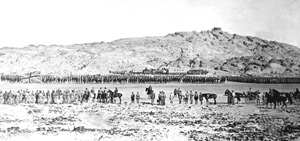
From Deutsch Südwest to mandated territory
Commander in Chief of the South African forces, General Louis Botha inspects the South African troops in Lüderitzbucht. (South African War Museum) Embanked Schutztruppe gunners commanding a view over the flat expanse west of Aus. (Museum Africa) History Book by Gordon McGregor, Mannfred Goldbeck: The First World War in Namibia. Gondwana Collection Namibia, Windhoek 2014, ISBN 978-99916-896-4-7, 180 pages, N$195.00)
History Book by Gordon McGregor, Mannfred Goldbeck: The First World War in Namibia. Gondwana Collection Namibia, Windhoek 2014, ISBN 978-99916-896-4-7, 180 pages, N$195.00)
This week, one hundred years ago, marks the beginning of the first contact between the military forces of the then Union of South Africa, and local German troops. Deutsch Südwest Afrika was one of the very few colonial territories drawn into the global conflict, later known as the Great War, still later called the First World War. To mark this important anniversary, local historians Gordon McGregor and Mannfred Goldbeck release their new book at the end of August,
The authors said the First World War continues to cast an immense shadow even today as it played a large part in shaping the modern world. For instance, it lead to the League of Nations Class C mandate over South West Africa, upon the insistence of General Jan Smuts, in the years immediately following the war.
100 years have passed since the outbreak of the First World War in August 1914. The hope that the German colonies, and thus German South West Africa, would not be drawn into the hostilities proved fruitless. Already on 13 September the war spread to South West Africa when a mounted South African regiment attacked the German police station at Ramansdrift on the border.
The first battle between troops of the Union Defence Force and the Schutztruppe for German South West Africa took place on 26 September 1914 at the Sandfontein watering hole between the Orange River and Warmbad.
As one of the countries outside of Europe that was drawn into the war, inadvertently embroiled in the unique situation that was transpiring in the Union of South Africa, Namibia’s history warrants inclusion in the worldwide WWI centenary commemorations.
An easily readable account of the war in German South West Africa, The First World War in Namibia adds interesting detail and aspects of the period not generally dealt with in classic history books. This includes the role of the indigenous population in the campaign, the plight of the animals and the various medals awarded.
It complements Gondwana’s History Series and is a noteworthy addition to the texts documenting Namibia’s rich history.
The book is available at the Gondwana offices in Klein Windhoek and at the Gondwana lodges.










































